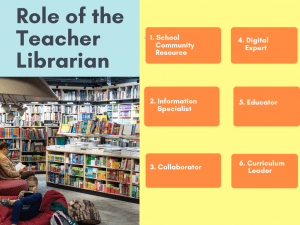Herring (2007) describes the role of the teacher librarian as ‘multi-faceted’ (p. 30) and depending on the needs of the school community may include: ‘Teacher, Librarian, Information services manager, Information literacy leader, Curriculum leader, Information specialist, Instructional partner, Website developer, Budget manager, Staff manager, Fiction and non-fiction advocate’ (p. 30-31). Based on my experience as a secondary school teacher, the role of the teacher librarian centred on being a school community resource, educator, curriculum leader, information specialist, digital expert and collaborator.
The Teacher Librarian is able to offer a unique perspective and is a vital school community resource, having specialised knowledge and skills in the ability to find and interpret information in an ever changing world. Lupton (2016) echoes the broad perspective teacher librarians have in the school community, particularly in relation to curriculum and pedagogy (p. 53). While we are exposed to information in faster ways than ever before, we are not born with the skills to sift through this information to find what we actually need. First and foremost, a teacher librarian is an educator, teaching students information literacy skills and digital citizenship. This view was supported by research conducted by Lupton (2016), which found that principals viewed teacher librarians ‘as a teacher first and librarian second’ (p. 58).
The teacher librarian is a curriculum leader, finding novel ways to meet the outcomes of the curriculum in new and exciting ways, providing easily aceesible resources for teachers. Teacher Librarians are Information specialists, instructing students on how to find, filter and assess quality sources of information. Hay (2006) found that teacher librarians provide valuable teaching to contribute to ‘student success in terms of completing quality research’ (p. 36). With ever changing technology and new platforms popping up for viewing and communicating information, the school community requires teacher librarians to be a digital expert leading the way ahead. Lupton (2016) found the role of the teacher librarian to increasingly include ‘the development of ICT skills and ICT pedagogical leadership’ (p. 57).
A teacher librarian is also a collaborator, working with teachers and executive to anticipate their needs and address their queries, to connect information resources within the library easily within their reach. Not just to show them new and improved ways of connecting to their students, but to ensure that these platforms are safe for them to use. McNee & Radmer (2017) found that collaboration between the teacher librarian and classroom teacher ‘leads to a statistically significant higher level of student skill development’ particularly in relation to valuable literacy skills due to increased access to resources, expertise, and connections to the broader school community (p. 7). Mardis (2016) suggests technology can build trust through collaboration within the school community using curriculum mapping tools, curation tools and digital note taking applications (p. 76).
Kompar (2016) highlights a growing role for teacher librarians to embrace – the ‘design/making/innovate movement provides teacher librarians with an opportunity to maximize the role of professional learning leader and instructional partner with resource specialist and innovative programmer’ (p. 60). Clearly, Teacher Librarianship is constantly evolving as new needs establish themselves within the school community and as the information landscape and technological platforms continue to change. It’s an exciting profession to be part of!
________
Hay, L. (2005). Student learning through Australian school libraries. Part 1: A statistical analysis of student perceptions. Synergy, 3(2), 17-‐‑30.
Hay, L. (2006). Student learning through Australian school libraries Part 2: What students define and value as school library support. Synergy, 4(2), 28-‐‑38.
Herring, J. (2007). Teacher librarians and the school library. In S. Ferguson (Ed.), Libraries in the twenty-first century : charting new directions in information (1st ed., pp. 27-42). Wagga Wagga, NSW: Centre for Information Studies, Charles Sturt University.
Kompar, F. (2016). Raise the Volume. Teacher Librarian, 43(4), 60–63.
Lupton, M. (2016). Adding Value: Principals’ Perceptions of the Role of the Teacher-Librarian. School Libraries Worldwide, 22(1), 49–61. https://doi-org.ezproxy.csu.edu.au/10.14265.22.1.005
Ruth V. Small, R. V. (2016). Overview: Creating a Collaborative Culture in a Digital Learning Environment. In M. A. Mardis (Ed.), Librarians and educators collaborating for success : The international perspective (Ed., pp. 69-81). ABC-CLIO, LLC.

You have documented the role of the TL well here and have accessed some good sources. You might also like to bring in some reflections of your own in to your blog posts. You can certainly use first person in these posts. Your blog looks great, and I love the infographic!